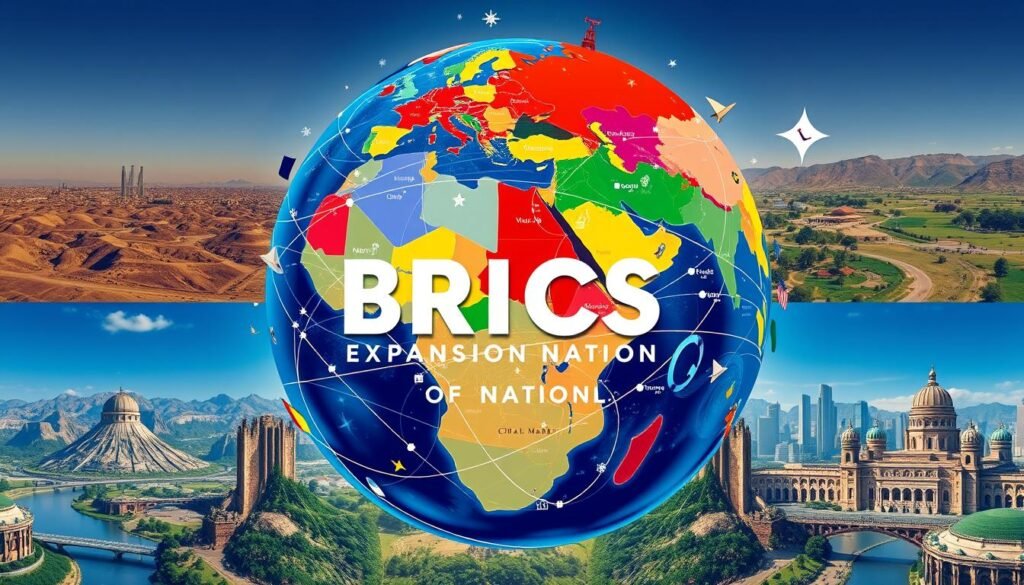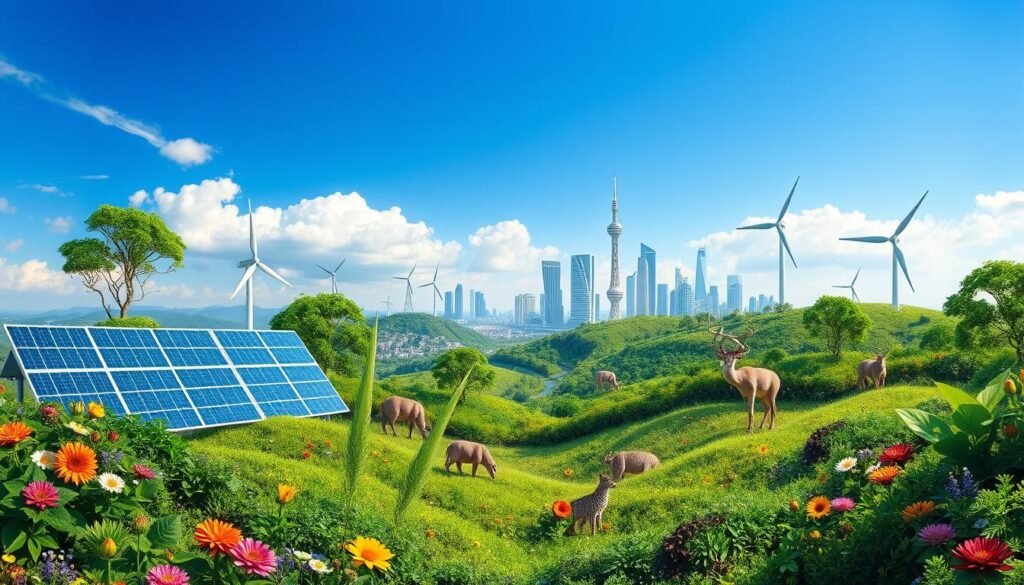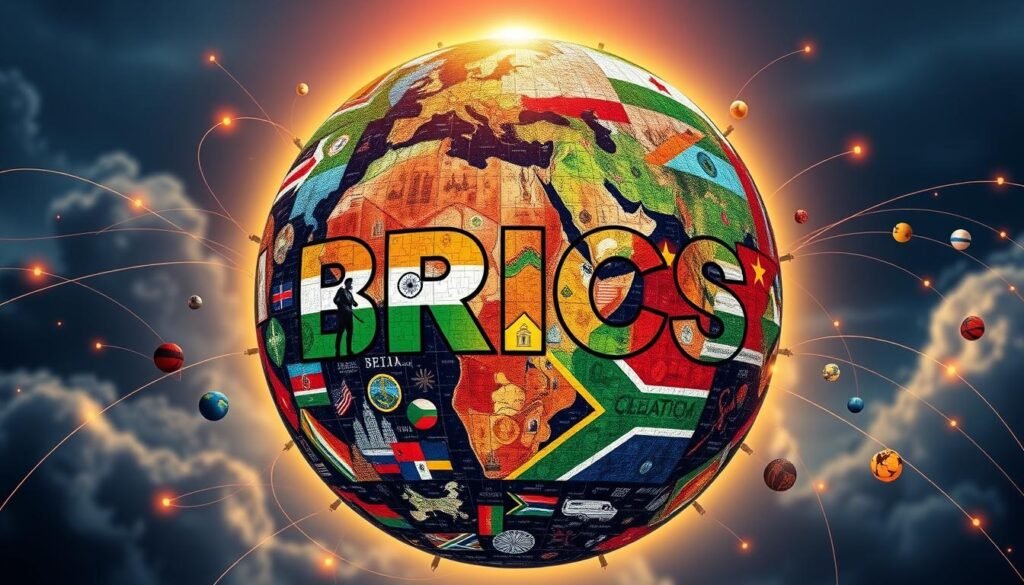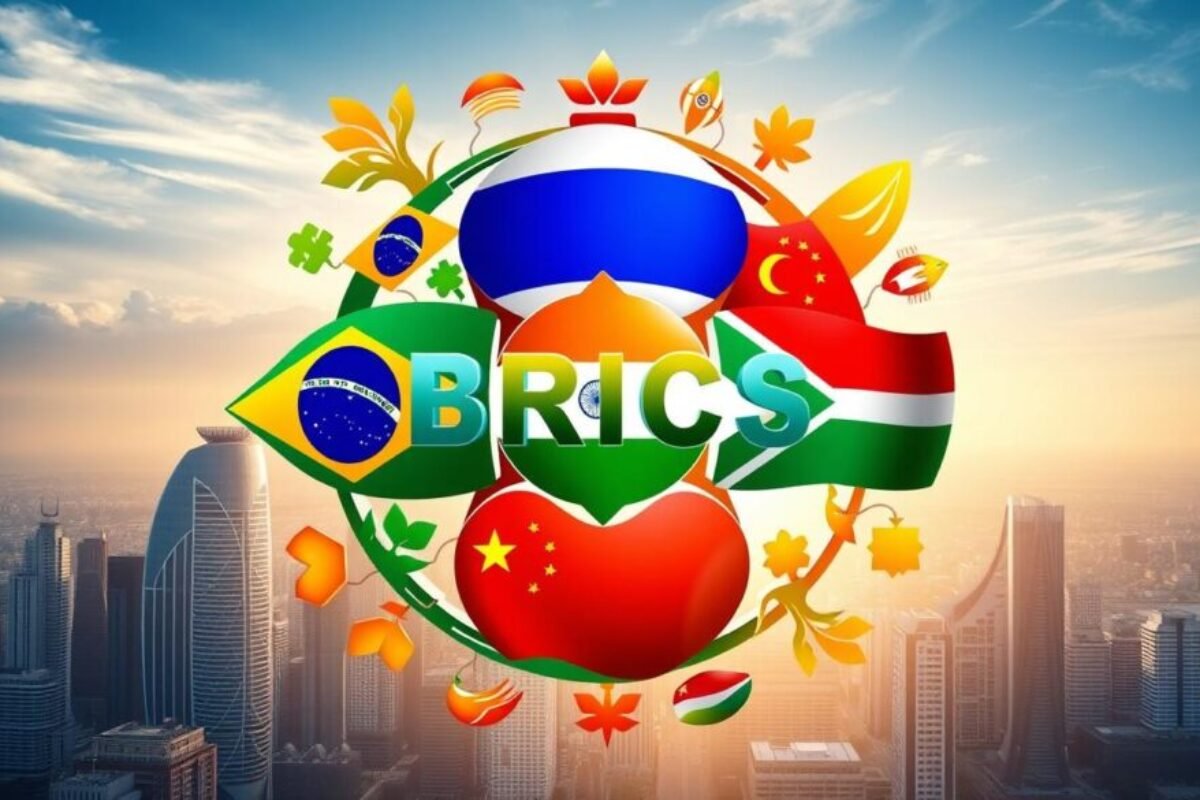BRICS 2024: The Shifting Power Dynamics in a Multipolar World
The world is gearing up for the BRICS summit in October 2024. This event marks a significant change in global power. The BRICS group, made up of Brazil, Russia, India, China, and South Africa, holds about 42% of the world’s population and 25% of its GDP1.
This group of emerging economies is set to influence international cooperation and global governance. The 2024 BRICS conference, set for October 22-24, is a key moment in this shift. It will gather these influential nations, who are pushing against Western dominance and advocating for a more inclusive world1.
India and China are leading this change, playing big roles in global affairs1. Many developing countries, from ASEAN, Latin America, and Africa, want to join BRICS1. This interest shows a growing desire for a global framework that gives more voice to emerging economies1.
Geopolitical players like Serbia, Turkey, and Cuba also want to join BRICS1. This could shake up the current global power structures1.
Key Takeaways
- BRICS collectively accounts for 42% of the global population and 25% of global GDP.
- The 2024 BRICS summit is expected to shape future global power relations.
- Developing countries are increasingly interested in joining BRICS to reduce Western influence.
- The expansion of BRICS could challenge Western-led institutions like NATO and the EU.
- BRICS is seen as a platform to amplify the voices of emerging economies on the global stage.
Understanding BRICS Evolution and Historical Context
The BRICS alliance, made up of Brazil, Russia, India, China, and South Africa, has become a major force in the world economy2. Together, these countries make up over a quarter of the global economy and nearly half of the world’s population2. Their rise shows a move towards a more inclusive world, challenging the old Western-dominated systems.
Origins and Formation of BRICS Alliance
BRICS started in 2009 as a response to global financial crises and dissatisfaction with Western institutions. In 2011, South Africa joined, making BRICS a strong economic and political force2. The idea of BRIC was first suggested by Jim O’Neill in 2001, predicting these four countries would greatly impact the world economy by 2050.
Historical Milestones
BRICS has hit many important milestones3. In 2024, it welcomed Egypt, Ethiopia, Iran, and the UAE, growing its influence3. If Saudi Arabia joins, BRICS could control 42% of the world’s oil, changing global energy3.
Initial Goals and Objectives
BRICS was created to offer a different path in the global scene, focusing on inclusivity and diverse views3. India, for example, wants to connect Western powers with emerging economies in BRICS3. The New Development Bank, started by BRICS, has funded over $32 billion for 96 projects, showing its dedication to growth and development2.
As BRICS grows, it stays committed to working together, strategic partnerships, and economic progress3. Its expansion and use of local currencies in financing show it wants to change the global economic order3.
BRICS 2024: Summit Agenda and Key Priorities
The BRICS alliance, made up of Brazil, Russia, India, China, and South Africa, is gearing up for its 2024 summit. The focus will be on boosting economic ties, improving trade and investment, and tackling global issues like climate change4. The group will also welcome new members, expanding its reach and influence4.
Strengthening Economic Cooperation Among Member Nations
The 2024 BRICS Summit aims to deepen economic bonds among its members. With BRICS covering about 45% of the world’s population and 25% of the global GDP4, the summit will look into ways to grow trade, investment, and financial ties. This is to drive sustainable economic growth and development5.
Enhancing Trade and Investment Frameworks for Emerging Economies
The 2024 BRICS Summit will focus on the needs of emerging economies. It will work on expanding trade and investment frameworks within the alliance. This includes strengthening plans for energy and food security, the international monetary system, and interbank cooperation5.
Addressing Global Challenges: Climate Action and Sustainability Goals
The 2024 BRICS Summit will emphasize the need for climate action and sustainable development. Member nations will work together to develop strategies and initiatives. These will aim to tackle climate change, promote renewable energy, and support sustainable economic practices5.
The Expansion of BRICS: Integrating New Members into the Framework
The 2024 BRICS Summit marks a significant moment for the alliance. It welcomes new members like Argentina, Egypt, Ethiopia, Iran, Saudi Arabia, and the United Arab Emirates6. This growth shows the increasing interest in the BRICS framework, with over 20 countries showing interest5. The inclusion of these new members will be a priority, aiming to amplify the voices of the Global South and promote a more inclusive global governance system6.

“The 2024 BRICS Summit will be a key moment, welcoming new members like Argentina, Egypt, Ethiopia, Iran, Saudi Arabia, and the United Arab Emirates. This growth shows the increasing interest in the BRICS framework, with over 20 countries showing interest.”
New Member Integration and Expansion Strategy
The BRICS alliance is growing and becoming more important on the world stage. Adding new member nations is a key strategy7. This expansion helps BRICS grow its influence and gives a chance for different countries to work together8.
Selection Criteria for New Members
BRICS picks new members based on where they are and their economic power8. Argentina, Egypt, and Ethiopia have joined to make BRICS stronger in certain areas7. Iran, Saudi Arabia, and the UAE have also joined, making BRICS more powerful in the Middle East7.
Impact of Geographic Diversity
The new BRICS members make the group more diverse and representative8. Now, BRICS covers 34% of the world’s land and 45% of its people8. This diversity helps BRICS speak for more countries, making global talks more inclusive8.
Strategic Benefits of Expansion
BRICS’ growth brings many benefits. It makes the group more influential and gives non-Western countries a stronger voice8. Adding countries like Iran and the UAE also boosts BRICS in the energy field7. This growth helps BRICS trade and invest more among its members7.
As BRICS grows, it will play a bigger role in global talks. It will help non-Western countries have a stronger say and create a more inclusive world8.
Economic Power and Market Influence
The BRICS alliance is growing in economic power and market influence worldwide9. These countries now make up 45% of the world’s population and 28% of the global economy9. Their trade among themselves has jumped 56% from 2017 to 2022, beating trade with G7 nations9.
This shows BRICS economies are doing better than G7 ones9.
Addressing Inflation and Economic Stability Challenges
The BRICS alliance is tackling big economic issues like inflation and keeping finances stable10. With 37% of the global economy, they’re using their strength to support economic growth and stability10.
Foreign Direct Investment Trends in BRICS Nations
BRICS countries are now more appealing for foreign investment, thanks to their strong economies and good investment climate10. Adding six new members has made BRICS even more attractive, with countries eager to invest in this economic group10.
BRICS and the Green Economy: Investing in Sustainable Development
The BRICS alliance is pushing for green economy and sustainable development11. BRICS+ now controls a big share of global oil and gas, from 8% to 40% for oil and 27% to 53% for gas11. This power helps BRICS invest in a greener, more sustainable future11.
| Metric | BRICS | G7 |
|---|---|---|
| Share of Global GDP (PPP) | 31.5%11 | 30.7%11 |
| Share of Global Oil Production | 42%11 | 20%11 |
| Share of Global Rare Earth Reserves | 72%11 | N/A |
| NDB Loan Portfolio | $32.8 billion11 | N/A |

The BRICS alliance is making a big impact on the global economy and politics10. As it grows and changes, its influence on the world will only get stronger9.
De-dollarization Initiatives and Financial Reform
The BRICS nations are working hard to use less U.S. dollar in international trade and finance. They want to boost economic growth, improve global cooperation, and change how the world is governed12.
Alternative Payment Systems
BRICS countries are creating new payment systems to trade and do business without the U.S. dollar. For example, Russian President Vladimir Putin announced the BRICS Pay system at a summit in Kazan, Russia13.
Currency Cooperation Framework
BRICS nations are also building a strong currency cooperation framework. This will help use BRICS+ currencies like the ruble and yuan for trade and investment within the group13. The group has grown to include more countries, with plans to add even more after the October 2024 summit13.
Impact on Global Trade
The BRICS de-dollarization plans will change how the world trades. In March 2024, over half of Chinese payments were in the renminbi, while 42.8% were in U.S. dollars12. China’s gold reserves have also increased, showing its effort to diversify its reserves12.
BRICS countries are pushing for more local currency use in trade. For example, 53% of China’s trade is in yuan, and over 90% of Russia-China trade is in yuan or ruble14. This trend is spreading, with 80 countries and Southeast Asian states moving towards local currency trade14.
These efforts will deeply affect global trade. BRICS nations and their partners aim to use less U.S. dollar and gain more financial freedom121314.

Geopolitical Implications for Global Order
The BRICS+ bloc is changing the world by giving a voice to emerging economies and the Global South15. This group is challenging the old Western-led world order. It could lead to a more balanced world where more countries have a say1615.
BRICS and the Global South: Amplifying Voices of Emerging Economies
BRICS+ now makes up 45.5% of the world’s population, more than four times the G715. This change gives the Global South more power in international decisions15. BRICS+ countries are using their strength to help developing nations on the world stage.
Geopolitical Risks and Opportunities in a BRICS-Centric World Order
The rise of BRICS+ as a counter to Western powers like the IMF and World Bank brings both risks and chances for the world15. With a combined GDP of $28.5tn and 25% of global exports, there are new chances for cooperation15. But, dealing with rivalries among big powers is a big challenge1615.
The growth of BRICS+ could lead to a more inclusive world system. Yet, it also makes international relations less stable and less predictable.
Technology and Cybersecurity: Geopolitical Leverage for BRICS Nations
BRICS+ countries are using technology and cybersecurity to show their strength globally161517. They are creating their own digital systems and improving their cyber security. This move aims to lessen their reliance on Western tech and finance15.
This shift is changing the balance of power and the future of digital cooperation worldwide.

“The rise of BRICS+ challenges the Western-dominated global order, potentially leading to a more multipolar world that provides greater representation for nations outside the traditional power centers.”
Strategic Partnerships and Regional Cooperation
The BRICS alliance is growing stronger by forming strategic partnerships and boosting regional cooperation. It’s working to improve trade between its members and share technology and innovation. This effort aims to make the group a powerful force in global affairs18.
Intra-BRICS Trade Relations
The 2024 BRICS Forum on Partnership on New Industrial Revolution (PartNIR) was a big event. It brought together leaders from BRICS countries and others to talk about trade and investment18. UNIDO launched projects like the BRICS Centre for Industrial Competencies to help BRICS countries grow their industries and trade with each other18.
Technology and Innovation Exchange
BRICS countries are working together on science, technology, and innovation. They see technology as key to boosting their economies and improving society19. At the PartNIR event, UNIDO’s AIM Global got more members, making the BRICS group stronger in tech and innovation18.
Cultural and Educational Initiatives
The BRICS alliance also focuses on cultural and educational exchanges. These efforts aim to deepen understanding and build connections between the diverse populations of BRICS countries20.
| Key Initiatives | Objectives |
|---|---|
| BRICS Centre for Industrial Competencies | Support industrialization and promote intra-BRICS trade |
| Smart Manufacturing Innovation Center (SMIC) | Facilitate technology and innovation exchange |
| AIM Global Centre of Excellence | Leverage AI and advanced technologies for industry and manufacturing |
The BRICS alliance is set to grow its influence through these efforts. It’s committed to cultural exchange, innovation, and strategic partnerships. These goals will help shape the future of the world20.
Challenges and Opportunities in the Multipolar Era
As the world shifts to a multipolar era, BRICS nations face both challenges and opportunities. They aim to shape global governance. They need to use diplomacy and strategic thinking to navigate complex geopolitical rivalries.
Multilateralism and inclusive global governance are key for BRICS. They want to make sure emerging economies have a voice in international forums21.
Navigating Geopolitical Rivalries
The multipolar landscape is complex for BRICS. They must balance the interests of diverse member nations. They also need to manage tensions with established global powers.
BRICS must navigate these rivalries carefully. They use their collective economic and political strength to protect their member states’ interests22.
Embracing Multilateral Diplomacy
The BRICS group sees the value of multilateral diplomacy in today’s world. They work to have constructive dialogue and collaboration. This is key for tackling shared challenges and achieving common goals.
By using the diversity of perspectives within BRICS, they can strengthen their voice globally22.
Toward a More Inclusive Global Governance
BRICS wants to change the global governance system. They aim for a more inclusive system that represents emerging economies better. By expanding the BRICS+ framework, they want to increase the influence of the Global South.
This shift to a multipolar world order offers both opportunities and challenges for BRICS. They aim to redefine the global rules2122.
Decentralized Power: Strengthening Resilience
BRICS believes in a decentralized power structure for resilience. They diversify economic and political partnerships. This reduces reliance on dominant global powers.
They aim to create a robust, interconnected network of nations. This ensures BRICS members are protected against external shocks. It also promotes a more equitable distribution of power internationally2122.
“The multipolar era presents both challenges and opportunities for BRICS. The group must navigate geopolitical rivalries and complex multilateral diplomacy while pushing for a more inclusive global governance system.”
Western Response and Global Realignment
The BRICS alliance is growing, changing the global scene. Western powers like the G7 and NATO are thinking about what this means. Some see it as a threat, while others see it as a chance for better cooperation.
G7 and NATO Perspectives
The G7 and NATO have mixed feelings about BRICS. Some worry it might upset the current world order23. But others think it’s a chance to work together better on big global problems.
Diplomatic and Economic Reactions
Western countries are reacting in different ways to BRICS’ growth. Some are tough, while others want to work together24. Talks on things like climate change are starting, showing we can solve problems together.
Future of International Cooperation
The rise of BRICS makes us wonder about the future of working together globally. Experts say we need to find a balance between different world views25. Talking openly, working together, and solving problems together could lead to a better world.
| Indicator | BRICS Nations | G7 Nations |
|---|---|---|
| GDP (Trillion USD) | 30.5 | 34.8 |
| Population (Billion) | 3.2 | 0.8 |
| Military Spending (Trillion USD) | 0.4 | 1.1 |
“The expansion of BRICS represents a significant shift in the global balance of power. While it presents both opportunities and challenges, it is vital that we engage constructively and build a more inclusive system of international cooperation.”
As we move into a world with more powers, working together is key. BRICS and Western groups need to find common ground. This will shape the future of alliances and global governance232425.
Conclusion
The 2024 BRICS summit is on the horizon, marking a big change in world power. The BRICS alliance, made up of some of the biggest emerging economies, is now a strong force26. It challenges the old Western dominance. With new members like Argentina and Saudi Arabia26, BRICS wants a more diverse and inclusive world.
The BRICS+ framework brings both chances and challenges. It shows a big change in the world order. As BRICS works on a shared plan for cooperation26, we’ll see a more balanced world. BRICS will help the Global South have a bigger say in global affairs.
The future of world relations will depend on BRICS’ success in diplomacy26. They must balance their growing group’s needs and tackle big issues like climate change. If BRICS succeeds, it will change global alliances, economic power, and balance for years to come.





February 10, 2025 @ 3:24 pm
I don’t think the title of your article matches the content lol. Just kidding, mainly because I had some doubts after reading the article.
February 20, 2025 @ 10:35 pm
Thank you for your sharing. I am worried that I lack creative ideas. It is your article that makes me full of hope. Thank you. But, I have a question, can you help me?
February 22, 2025 @ 7:21 am
Your article helped me a lot, is there any more related content? Thanks!
March 1, 2025 @ 9:42 am
Can you be more specific about the content of your article? After reading it, I still have some doubts. Hope you can help me.
March 3, 2025 @ 3:09 am
Your article helped me a lot, is there any more related content? Thanks! https://accounts.binance.com/en-NG/register?ref=JHQQKNKN
March 6, 2025 @ 1:11 pm
Thanks for sharing. I read many of your blog posts, cool, your blog is very good.
April 5, 2025 @ 3:36 am
I don’t think the title of your article matches the content lol. Just kidding, mainly because I had some doubts after reading the article.
April 9, 2025 @ 7:40 pm
I don’t think the title of your article matches the content lol. Just kidding, mainly because I had some doubts after reading the article.
August 3, 2025 @ 12:00 pm
Your point of view caught my eye and was very interesting. Thanks. I have a question for you.
August 13, 2025 @ 11:30 am
I don’t think the title of your article matches the content lol. Just kidding, mainly because I had some doubts after reading the article.